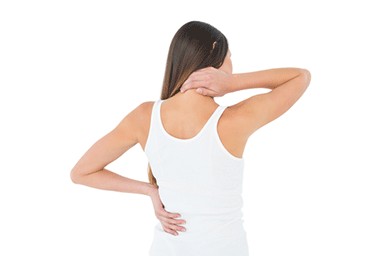Care for backs and bones

Without a strong back and skeleton it is hard to enjoy life. Be proactive with your back and understand problems which may arise
- understand common causes of back pain
- rule out anything serious
- take care of your bones
With Dr Morton’s - the medical helpline© you can email or phone a real doctor at any time for more information, reassurance or advice
Dr Morton's Sports Injury Pack©
Back pain is very common
Lower back pain is one of the most common complaints seen by general practitioners.
Although the cause is often not immediately clear in the vast majority of cases, the symptoms are self limiting and respond to simple treatments. The usual description given for this common problem is 'mechanical back pain'.
Other causes of back pain include
- slipped disc (otherwise known as prolapsed disc). This can be responsible for back pain and or sciatica (pain in the leg)
- an accident with spinal injury resulting in back pain
- occasionally back pain can be the first symptom of a serious illness, such as a spinal infection or cancer
Symptoms
There are several so called 'red flag' symptoms that may prompt further investigation by a doctor. These include
- perianal (close to the anus) or perineal (between the legs) numbness
- progressive pain, numbness or weakness in the legs, especially when in both legs
- continuous pain, not relieved by lying down
- night pain
- fevers
- chills or weight loss with back pain
- previous history of cancer
- structural deformity of the spine
- sudden onset pain in people with osteoporosis
- thoracic back pain (pain in the part of your back above your waist)
Other conditions can give similar symptoms such as
- kidney infection
- flu
- dengue fever
When you should contact a doctor
New onset red flag symptoms should be discussed with a doctor urgently. Any back pain or sciatica that does not respond to standard treatments after six weeks should be discussed with a doctor.
Available treatments
In most instances acute low back pain will be self limiting. It is advisable to remain active, bed rest is not recommended. Simple analgesia is traditionally prescribed although recent evidence suggests that paracetamol has no greater benefit than a placebo. Manipulative therapy is also useful. This may take the form of physiotherapy, osteopathy or chiropractic care. There is some evidence that acupuncture can be helpful. Attention to physical fitness will, to some extent, limit recurrent problems. Improving your level of spinal fitness such as by walking, or doing core strengthening exercises such as Pilates is considered protective.
A minority of people presenting with red flags symptoms will require urgent surgical treatment. Impending spinal cord compression can be caused by massive disc herniation, tumour, fracture or infection. Untreated, this can cause paralysis and incontinence.
Take care of your bones
Making healthy choices will help maintain your bone health.
Being obese, drinking too much alcohol and smoking are all bad for your bones. On the contrary maintaining a healthy weight and taking regular weight-bearing exercise will be protective.
Healthy adult bones are in a constant state of turnover with old bone being reabsorbed and new bone being laid down to replace it. This is a bit like a motorway where the road surface is constantly being worn out and then replaced. Osteoporosis (OP) or brittle bone disease is common in older women because after the menopause new bone formation virtually ceases. To use the motorway analogy, the road surface gets worn out but is not replaced. Thus the bones become brittle and will break easily. If you have an early menopause, a family history of osteoporosis, are a heavy drinker, smoker, do little exercise or have taken medication such as long-term steroids, you may be at increased risk of developing OP and should discuss this with a doctor. You may be referred for a bone mineral density (BMD) scan, the result of which can then be used with an online tool called a FRAX score to determine your risk of having a fragility fracture. This will inform you whether or not treatment is needed.
There are a variety of treatments for OP of which bisphosphonates (for example alendronate and risedronate) are the most commonly used.
Men are at far less risk of developing OP than women but they can get it. The cause is often unknown but it is frequently associated with persistently low testosterone levels.
Calcium and Vitamin D are needed for new bone formation so it is important to make sure your diet contains at least 700mg calcium per day (equivalent of 1 pint of semi skimmed milk) and that you get adequate Vitamin D. Vitamin D is found in eggs, milk and oily fish but we make most of what we need from exposure to sunlight. Ten minutes exposure twice daily is thought to be adequate. However, Vitamin D is very topical and has recently been linked to a variety of other conditions from multiple sclerosis to cancer and it seems likely that the recommended daily amount may increase as we discover more.
Related topics
- broken finger - a surgeon's view
- shin splints
- struck down by back pain
- back care awareness
- slipped disc
- broken face bones
- broken ankle

